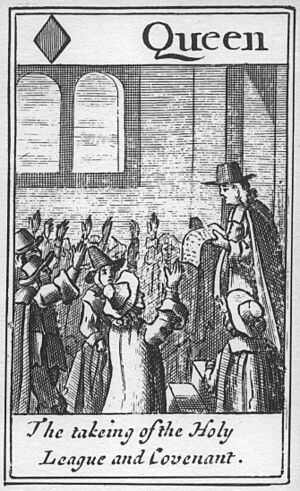Solemn League and Covenant facts for kids
The Solemn League and Covenant was an important agreement made in 1643 during the First English Civil War. This war was part of a bigger conflict called the Wars of the Three Kingdoms, which involved England, Scotland, and Ireland. The agreement was signed between the Scottish Covenanters and the English Parliamentarians.
The Covenanters were a group in Scotland who strongly supported the Presbyterian way of running the church. The Parliamentarians were the side fighting against King Charles I in England. On August 17, 1643, the Church of Scotland (also known as the Kirk) agreed to the Covenant. A month later, on September 25, 1643, the English Parliament and the Westminster Assembly also accepted it.
Contents
Why England's Parliament Needed Help
At this time, the Protestant leaders in the English Parliament were fighting against King Charles I. They were worried that Irish Catholic soldiers might join the King's army, which was called the Royalist army. Because of this fear, Parliament asked the Scots for help.
The Scottish Covenanters said they would help, but only if England agreed to adopt the Scottish system for running the church. This system was called Presbyterianism. Most members of the English Long Parliament agreed to this. Many of them were Presbyterians themselves. Others simply preferred to team up with the Scots rather than lose the Civil War.
What the Covenant Said

After some discussions, a document called "The Solemn League and Covenant" was created. It was like a treaty between the English and Scottish parliaments. Its main goals were:
- To protect the reformed religion in Scotland.
- To reform (change) religion in England and Ireland. This meant making it more like the "best reformed churches" and following "the word of God."
- To get rid of Catholicism (called "popery") and the old system of bishops in the Church of England (called "prelacy").
The agreement did not specifically say "Presbyterianism." It used some phrases that were a bit unclear. This allowed other groups, like the English Independents, to also agree to it. The Independents were another strong group on the English Parliament's side, especially in their armies. Many people in England, Scotland, and Ireland signed the Covenant. The English Long Parliament approved it, and the Westminster Assembly of Divines also agreed with some small changes.
However, not everyone on the English Parliament's side was happy. Some, like John Lilburne, chose to leave the army rather than take the oath required by the Covenant.
Scots Join the Fight
Because of this agreement, the Covenanters sent another army south into England. This Scottish army joined the Parliamentarian side in the First English Civil War in January 1644. A new group, the Committee of Both Kingdoms, was formed to manage the war against King Charles I. This committee included representatives from both England and Scotland.
After the First Civil War ended, the Scots left the committee. It continued to meet and was then known as the Derby House Committee.
Charles I and the Second Civil War
After the Royalists lost the First Civil War, King Charles I made a secret deal with most of the Covenanters. This deal was called the "Engagement." In it, the Covenanters agreed to support Charles I in the Second English Civil War. They would fight against their shared enemy, the English Independents. In return, Charles promised to make Presbyterianism the official church system in England for three years.
However, in 1648, the Royalists and Covenanters were defeated at the Battle of Preston. King Charles I was executed in January 1649.
Charles II and the Third Civil War

After the Kirk Party (a group of Covenanters) took power in Scotland, they convinced Charles II to agree to the Solemn League and Covenant. Charles II was in exile at the time. He signed the agreement in the Treaty of Breda (1650).
However, the Royalist and Scottish army was defeated at the Battle of Worcester in 1651. This battle ended the importance of the Solemn League and Covenant. The power of the Presbyterians was broken in both England and Scotland.
After the Restoration
After the Restoration (when the monarchy was brought back to England), the English Parliament passed the Sedition Act 1661. This law declared that the Solemn League and Covenant was illegal. It also said that anyone holding a public office had to reject it. The act even ordered that copies of the Covenant be publicly burned.
See also
- Protestation Returns of 1641–1642
- List of treaties

